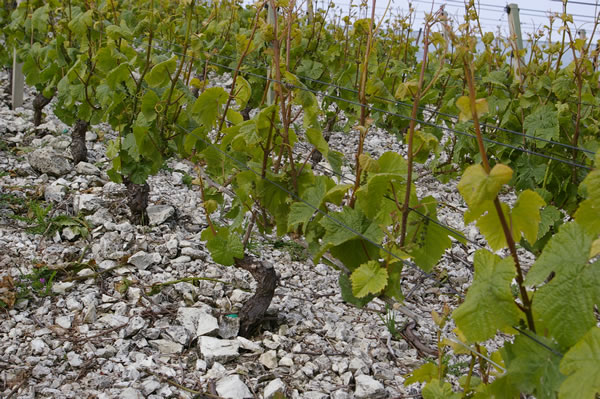So, the next instalment in my exploration of the importance of soils for wine. This is really thinking aloud, so I’d love to hear comments and corrections.
One of the most important properties of vineyard soils is how they control water supply to the vine. Vine roots are designed to be particularly effective in taking up water and nutrients from the soil, because owing to their climbing habit in the wild, they are establishing themselves in soils already colonized by other plants. Supply vines with too much water and they will grow big, lush canopies and not put much effort into grape production.
A famous study on the soils of the Médoc (Bordeaux) was carried out by researcher Gérard Seguin in the 1980s. He found that many of the best vineyard sites had poor levels of soil nutrients, but that this was compensated for by deep root systems. These top sites were frequently acidic gravels, and showed magnesium deficiency due to high potassium levels, as well as low levels of nitrogen. But aside from this, it was hard to correlate potential wine quality and soil nutrient levels. Seguin stated that, ‘it is impossible to establish any correlation between quality of wine and the soil content of any nutritive element.’ He adds that if there were to be such a correlation, you could give yourself a good chance of making great wine simply with the assistance of chemical additives to the soil.
Seguin’s major conclusion was that the vital way in which the soils affected grape quality was through regulating water availability during the vegetative cycle of the vine. Moderate water deficit has been shown to reduce shoot growth (vigour), berry weight and yield, and increases berry anthocyanin and tannin content: ideal for high quality red wine production. Vine water status is dependent on soil and climate characteristics, and soil influences vine water status through its water-holding capacity. Seguin showed that in the Bordeaux vineyards, which are not irrigated, berry size is decreased and total phenolics are increased when vines face water deficits, resulting in higher grape quality potential but lower yields.
A more recent study by Bordeaux-based terroir researcher Kees van Leeuwin, who has worked with Seguin in the past, examined this in more detail. Van Leeuwin and colleagues looked at 32 vintages in Bordeaux from 1974–2005 and found a correlation between vine water deficit stress index and vintage quality ratings. ‘The quality of red Bordeaux wine can be better correlated to the dryness of the vintage than to the sum of active temperatures,’ he concludes. In none of these vintages included in the study did the quality suffer because of excessive water deficit. Vintage quality ratings don’t correlate well with the average growing season temperatures, which is surprising. However, the story isn’t a simple one: some vintages, such as 1982, were excellent with no real water deficit.
In Bordeaux, the vineyards that rarely experience deficit are either planted to Merlot, or to white varieties. Closer planting, growing higher canopies, and using rootstocks that only partially use soil water reserves (such as Riparia Gloire de Montpellier) are vineyard interventions that can be used on sites that usually lack natural water deficit.
But water deficit is not always associated with higher wine quality. As part of his PhD studies, Jean-Sebastien Reynaud looked at the effect of soil water-holding capacity on wine quality in 23 different Vaud (Switzerland) vineyards. These were planted with Gamaret, a Swiss variety that’s a cross between Gamay and Reichensteiner, and is popular in Switzerland because of its resistance to botrytis. Many studies of water deficit have involved irrigated vineyards, but Reynaud looked at unirrigated sites over three vintages, 2007–2009. Water stress can have both positive and negative effects on vines. In drying soils, plant roots synthesize abscisic acid which signals to the above-ground portion of the plant and encourages grape ripening, and the partitioning of carbon resources to the fruit rather than the canopy. But it also causes stomatal closure, reducing carbon assimilation. If the stress is severe then leaves are lost. So stress tends to increase soluble solids in the grape (generally good for wine quality, especially in reds) until it reaches a certain point and soluble solids decrease when the stress is too much.
Reynaud found that water deficit improved wine colour, but there was no clear relation between water stress and the sensory attributes of the experimental wines he made. ‘In the Vaud conditions vine water stress was not the major parameter responsible for differences in wine quality,’ he concluded.
Perhaps Seguin’s viewpoint that water-holding capacity is the key soil factor for wine quality – widely accepted around the wine industry, particularly for red wines – has overshadowed the potential importance of soil chemistry. The soils he studied were of a certain type: what Chilean terroir expert Pedro Parra describes as ‘geomorphic’ soils—those where the soil isn’t formed directly from the underlying bedrock. Parra suggests that ‘geological’ soils, formed from weathered bedrock, may be quite different in this respect than geomorphic soils. Examples of gemorphic soils would include alluvial soils such as those of Bordeaux, or wind-blown loess. In contrast, the soils of Burgundy and the Rhône would be geological.
What about clays? Clays are made of the smallest of all soil particles, and because of their structure present an extremely large surface to volume ratio. They can hold water and nutrient ions very effectively. ‘I’d always thought that clay was an unlikely viticultural soil,’ says John Atkinson MW, who has a vineyard in the UK and is the author of an interesting research paper on terroir in Burgundy’s Côte de Nuits. ‘It just seemed so charged with minerals and water, and therefore overly invigorating in temperate climates. I was therefore surprised to read in Denis Dubordieu’s two volume work on oenology that Petrus’ smectite clay soil hydrically stressed the property’s Merlot vines.’
‘I read around the subject,’ continues Atkinson, ‘and came across a report on Geelong’s [Victoria, Australia] soils. The article makes the important distinctions between soil water capacity, availability and extractability.’ Atkinson points out that clay soils hold onto their water, and their density makes rooting difficult. ‘Clays might appear humid, but extractability can limit availability,’ he adds. ‘This tied-in with a paper I’d read by Kees van Leeuwen, which reported hydric stress occurring more rapidly in vines grown on a clay-based Bordeaux soil than they did on a more typical Medoc gravel soil.’
Apparently, Petrus, the famous Pomerol estate, has more smectite clay than any other estate in Pomerol. ‘Smectite is a volcanic mineral that increases the internal surface areas of clays, and exaggerates their shrink swell properties,’ says Atkinson. ‘It is part of the montmorillonite group of clays. Expansion of the clays closes the pores in the soil, and makes conditions too anaerobic for root growth whilst impeding existing root function. Consequently, they impose a limit on the extractability of water by limiting root development. Conversely, as smectite/momtmorillonite clays dry out, they shrink and crack, allowing rootlets to populate the developing capillaries. By contrast, Kaolinite and illite clays expand and contract very little.’
‘The relevance of all this is that one could model a viticultural regime based upon montmorillonite clay, warm summers and irregular rainfall in which vines are nearly always under stress; even heavy rainfall wouldn’t penetrate the soil, because the clays expand and seal at their surfaces. Petrus would be the paradigm of this sort of interaction.’
The main focus of Atkinson’s work on terroir has been in Burgundy. The famed vineyards of the Côte d’Or are on the side of a rift valley, and because of this soil can vary over the course of just a few metres. Atkinson says that the best vineyards are those where there is limestone bedrock and plenty of active calcium carbonate, which helps create an open soil structure. The flocculated clays in these soils have the physical drainage properties of sand, but can hold nutrients. The porous limestone soils can help with drainage because of their effect on the structure of the soil, but can also act as a water reserve. The clay content in the soil is able to extract the water from the limestone reserve, and make it available in limited quantities through the growing season. The red Grand Crus typically have smectite (swelling clays), while those with kaolinite clays are better suited to white wines.
Atkinson cites the work of Frank Wittendal, who used a statistical technique called principal components analysis (PCA) to look in detail at 2816 specific climats in Burgundy. The climat is the Burgundian terroir unit, and represents a single patch of presumably homogeneous terroir. This may be a vineyard in its entirety, or may just be a part of a larger vineyard. For example, Clos de Vougeot is a 50 hectare Grand Cru vineyard with 16 climates, while Corton, another Grand Cru vineyard, has 24 climats.
Wittendal described each climat in terms of 14 soild description variables and four landscape/climatic variables, which were then fed into the PCA. The great significance of this work is that by using statistics, he was able to show that factors that would assume to be important – such as altitude, aspect, parent rock and gradient – weren’t significant in separating out the different hierarchical levels in Burgundy’s vineyards.
The PCA work shows that in terms of vineyard classification, the soil properties are really what matter, and these have precedence over altitude and slope. There is some evidence that east facing vineyards are favoured, but this is because facing east correlates well with interesting soil types, rather than the angle of the sun’s illumination.
Wittendal’s analysis was able to split the different climats up into three quite separate groups. Group 1 consists of colluvial soils. These are formed by the accumulation of fallen, eroded soils which are retained on shallow slopes. Colluvium is made of fragmented rocks. Group 2 is non-colluvial compact limestone. This is able to retain water and possibly sequester it from deeper sources. Group 3 is alluvial soils, at the lower end of the altitude and slope indicators. There is just one Grand Cru climat with an alluvial soil, a Bâtard Montrachet. Root growth in limestone and colluvial soils is quite different. In the limestone soils, roots go mainly down, searching for water. In colluvial soils, made of fragmented rocks, roots travel in all directions.
If just the red Grand Cru vineyards are included, then 80–90% of the clayey limestone soils with active carbonate are eliminated, and the majority soil type is colluvium. That is, the Grand Cru vineyards had a high proportion of gravelly, colluvial hillwash in their subsoils. Atkinson suggests that the significance of this is that the best vineyards put the vines into the optimal deficit zone, and it’s the hydrology properties of the vineyard that determine its quality potential. This is similar to the findings of Seguin and others in Bordeaux, where the alluvial sand and gravel soils, coupled with a retreating water table in the summer, puts the vines into deficit. In the best Bordeaux vineyards clay lenses run through the soil helping to buffer water availability, keeping the vines supplied with just enough water but letting them experience mild deficit.
1 Comment on On soils and wines, part 6 – water relations and wine quality, plus a bit about clays


Thanks for this extremely interesting series of posts.